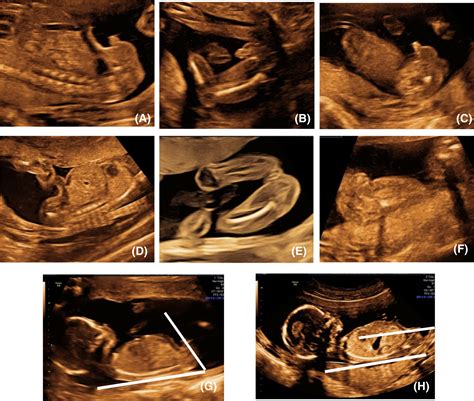Welcoming a baby into the world is an extraordinary journey filled with anticipation and wonder. As expectant parents, one of the most exciting aspects is discovering the sex of your little bundle of joy. Filled with curiosity, we often seek ways to uncover this secret before the big day arrives. While many traditional methods have been passed down through generations, advancements in science have opened up a new realm of possibilities for determining the gender of your baby.
Unraveling the Enigma:
Beyond waiting for the ultrasound scan or merely relying on old wives' tales, a multitude of techniques have emerged that claim to offer insights into your baby's gender. From genetic tests to various non-invasive procedures, expectant parents are now presented with an array of options to satiate their curiosity. Exploring these methods provides not only valuable information but also a deeper connection to the miracle of life growing within.
Charting the Course:
Navigating the vast array of gender prediction methods can be overwhelming. With each approach claiming accuracy, it is important to assess their credibility and scientific basis. Whether it's analyzing parental traits, observing dietary patterns, or consulting medical experts, understanding the pros and cons of each method is vital in making an informed decision and managing expectations. Let us delve into some of these techniques, empowering you to unravel the enigma and pave the path towards revealing your baby's gender.
New Advances in Prenatal Techniques for Determining Fetal Gender

In the ever-evolving field of prenatal research, significant advancements have been made in recent years towards accurately determining the sex of a baby before birth. These groundbreaking techniques utilize cutting-edge technology and innovative methodologies to offer expectant parents a glimpse into the gender of their unborn child.
One noteworthy approach involves analyzing cell-free fetal DNA (cffDNA) present in the mother's bloodstream during pregnancy. Through a process known as non-invasive prenatal testing (NIPT), scientists can examine this genetic material to identify specific chromosomal patterns associated with male or female fetuses. This non-invasive method eliminates the need for invasive procedures and offers a safe and reliable means of gender determination.
Another groundbreaking technique relies on advanced ultrasound imaging technology. By meticulously analyzing various fetal characteristics and traits, skilled sonographers can make accurate predictions about the baby's sex. These ultrasound assessments consider factors such as genital development, the presence of the "angle of the dangle," and the visualization of external genitalia. This non-invasive approach ensures a high degree of accuracy and is widely regarded as a valuable tool in prenatal gender determination.
Furthermore, recent research has explored the potential of analyzing the mother's urine samples for the presence of specific hormones or biomarkers that may indicate the gender of the fetus. These emerging methods, although still in the experimental stage, show promising results and offer a non-invasive alternative for determining fetal gender.
Additionally, advancements in genetic sequencing technologies have opened new doors in prenatal gender determination. Scientists are now able to sequence the entire fetal genome from a simple blood sample obtained from the mother. By analyzing the genetic code, sex-specific markers can be identified, providing accurate information on the baby's gender. This innovative approach has the potential to revolutionize prenatal care and provide precise gender determination results.
As research and technology continue to progress, expectant parents will have access to increasingly accurate and non-invasive methods for determining their baby's gender before birth. These new advancements offer a greater understanding of fetal development and empower parents in their journey towards welcoming their new addition to the family.
The Genetic Factors Influencing the Determination of Your Baby's Biological Sex
Introduction: Exploring the crucial role of genetics in the intricate process of determining the biological sex of your forthcoming child.
Chromosomal Foundation: Genetics play a foundational role in shaping the biological sex of a developing baby. The intricate interplay of chromosomes and genes is responsible for the establishment of either male or female characteristics.
Inheritance Patterns: The biological sex of a baby is determined by the combination of sex chromosomes inherited from both parents. While females inherit two X chromosomes (XX), males inherit one X and one Y chromosome (XY).
Role of Sex Chromosomes: The presence of the Y chromosome holds the key in initiating the developmental process towards male characteristics, including the production of testosterone. The absence of the Y chromosome leads to the development of female characteristics.
Genetic Variations: In some cases, genetic variations or mutations can influence the usual determination of biological sex, leading to conditions such as intersex or chromosomal abnormalities.
Genetic Testing: Technological advancements in genetic testing enable prospective parents to assess the likelihood of certain genetic conditions and determine the baby's biological sex with higher accuracy.
Environmental Factors: While genetics provide the groundwork for determining the biological sex of a baby, it is important to note that certain environmental factors can also impact gender identity and expression later in life.
Ethical Considerations: The increasing accessibility of genetic testing raises ethical dilemmas surrounding the potential misuse of genetic information or the interference with the natural process of prenatal development.
Conclusion: Understanding the role of genetics in determining the biological sex of your baby provides valuable insights into the fascinating complexities of human reproduction. Nonetheless, it is important to approach this knowledge with sensitivity, recognizing the diverse nature of gender identity and expression.
Various Techniques to Determine the Gender of Your Child at Home

Discovering the sex of your unborn child is an exciting and eagerly anticipated moment for expectant parents. While professional medical procedures provide accurate results, there are also popular at-home methods that offer a glimpse into the gender of the baby. These techniques, based on traditional beliefs and old wives' tales, can be both entertaining and mysterious, giving parents a chance to speculate and bond with their growing baby.
| Method | Description |
|---|---|
| Chinese Gender Calendar | According to Chinese folklore, this ancient lunar calendar can predict the baby's gender based on the mother's age and the month of conception. |
| Ring Swing Test | Using a thread and a ring, this method involves dangling the ring over the pregnant woman's belly, indicating the gender based on the ring's motion. |
| Baking Soda Gender Test | This home-based experiment combines urine and baking soda to determine the baby's gender, with the reaction supposedly varying depending on the sex. |
| Skull Theory | Based on the shape and characteristics of the baby's skull in an ultrasound image, some believe they can detect subtle differences indicating the gender. |
| Mayan Gender Prediction | Mayan civilization had their own gender prediction method, involving the mother's age at conception and the year of conception. |
| Intuition and Dreams | Many people believe that a mother's intuition and dreams can provide insight into the gender of the baby. |
Although these techniques are purely for entertainment purposes and lack scientific validity, they contribute to the joyful anticipation and excitement surrounding the discovery of a baby's gender. It is important to remember that the only guaranteed method for accurate gender determination is through medical procedures conducted by healthcare professionals.
Understanding the Reliability of Ultrasound Determination for Predicting Fetal Sex
Exploring the accuracy of ultrasound assessments in predicting the sexual characteristics of a developing baby is crucial in providing expectant parents with realistic expectations regarding their child's gender. By comprehending the level of reliability associated with ultrasound gender assessments, individuals can better understand the potential limitations and uncertainties involved.
Assessing Ultrasound Determination Precision
When examining the precision of ultrasound gender determination, it is essential to consider various aspects that may influence the outcome. Factors such as fetal positioning, gestational age, and the expertise of the sonographer all play significant roles in determining the accuracy of the results. Additionally, the techniques used for ultrasound assessment, such as the angle of the transducer and the clarity of the image, can impact the reliability of the gender determination.
Evaluating the Margin of Error
While ultrasound technology has significantly advanced in recent years, it is important to note that there is still a margin of error associated with gender determination. This margin of error generally ranges from 95% to 99%, indicating that there is a slight possibility of misidentification when determining the sex of a fetus. Understanding and acknowledging this potential margin of error can help parents approach ultrasound gender assessments with tempered expectations.
Considering the Timing of Ultrasound Gender Determination
Timing plays a crucial role in the accuracy of ultrasound-based gender determination. Studies have shown that the accuracy of predictions tends to increase as the gestational age progresses. Thus, it is recommended to undergo ultrasound assessments later in pregnancy to achieve a higher level of reliability. This consideration can help individuals make informed decisions on when to schedule their ultrasound examinations for gender determination.
The Importance of Sonographer Expertise
The skill and experience of the sonographer performing the ultrasound assessment significantly contribute to the accuracy of gender determination. Understanding the significance of selecting a qualified and experienced sonographer can enhance the reliability of the results. Confirming the expertise of the sonographer can be achieved by requesting certifications and reviewing feedback from previous patients.
Conclusion
By comprehending the various factors that influence the reliability of ultrasound gender determination, expectant parents can approach the process with an informed perspective. Recognizing the potential limitations and acknowledging the margin of error can help individuals establish realistic expectations and minimize potential disappointment.
The Fascinating Phenomenon of Gender Swapping during Gestation

In the realm of expectant parents eagerly awaiting the arrival of their little ones, there exists an intriguing occurrence that often captures their attention – the captivating phenomenon of gender swapping. This remarkable process takes place during the course of pregnancy, bestowing upon a developing fetus the ability to potentially change its assigned gender. While not widely known, this phenomenon brings forth a multitude of questions and sparks curiosity among those seeking to understand the depths of human reproduction.
Unveiling the Mysteries of Gender Swapping
Diving deeper into the intricacies of this phenomenon, it becomes apparent that gender swapping occurs through a series of complex biological events culminating in the alteration of a baby's assigned sex during gestation. These events, fueled by a unique interplay of genetic and hormonal factors, hold the power to shape and redefine an individual's gender identity before they even enter the world.
Exploring the Genetic Factors
At the heart of gender swapping lies the intricately woven web of genetic information. Within the chromosomes present in every cell, the genetic codes for both male and female characteristics coexist, awaiting their role in shaping the baby's development. It is through this intricate dance of genes that the phenomenon of gender swapping manifests, as certain genes may be activated or deactivated, leading to a shift in the baby's expressed gender.
Unraveling the Role of Hormones
Beyond the genetic factors, hormones also play a significant role in the phenomenon of gender swapping. These chemical messengers, secreted at precise moments during pregnancy, can influence the development of reproductive organs and secondary sexual characteristics. Through the delicate balance of hormone levels, the fetus may experience changes in its physical attributes, ultimately contributing to the fascinating process of gender swapping.
The Impact and Implications
Understanding the phenomenon of gender swapping not only deepens our comprehension of the complexity of human development, but also raises questions about the significance of gender identity and its fluid nature. The phenomenon challenges traditional notions of static gender roles and prompts a broader conversation about the diverse experiences individuals may have in relation to their assigned sex. Ultimately, recognizing and embracing the existence of gender swapping expands our understanding of the beautiful diversity of human life.
Dispelling Traditional Beliefs: Challenging Age-old Myths about Determining the Gender of Your Child
Within the realm of predicting the sex of an unborn child, countless myths and superstitions have persisted across cultures for centuries. These age-old tales have been passed down through generations, with some firmly believed to hold the power of determining the gender of a baby. However, it is crucial to separate fact from fiction when it comes to gender prediction during pregnancy, as these myths have no scientific basis and should be approached with skepticism.
One popular myth is that the cravings experienced by a pregnant woman can reveal the sex of her baby. According to this belief, cravings for sweet foods are a sign of carrying a girl, while savory or salty cravings indicate the presence of a boy. Despite its widespread acceptance, there is no scientific evidence to support this claim. Cravings during pregnancy are primarily influenced by hormonal changes and individual preferences, rather than the gender of the baby.
Another widely held belief is that the shape of the mother's baby bump can provide clues about the sex of the child. It is often claimed that a round and high bump suggests a girl, while a low and pointed bump indicates a boy. However, the shape of the baby bump is primarily determined by the mother's body structure, muscle tone, and the position of the baby in the womb. There is no correlation between the shape of the bump and the gender of the baby.
Furthermore, the notion that the speed of a baby's heart rate can determine its gender has been prevalent for generations. This myth suggests that a heart rate of above 140 beats per minute indicates a girl, while a lower heart rate signifies a boy. However, numerous scientific studies have debunked this belief, revealing that the heart rate of a developing fetus can fluctuate throughout pregnancy and is influenced by various factors such as fetal activity, gestational age, and maternal heartbeat.
| Myth | Debunked Information |
|---|---|
| Cravings | The type of cravings experienced by a pregnant woman has no correlation to the gender of the baby. It is primarily influenced by hormonal changes and individual preferences. |
| Baby Bump | The shape of the baby bump is determined by the mother's body structure, muscle tone, and the position of the baby, not by the gender. |
| Heart Rate | Contrary to popular belief, the heart rate of a developing fetus varies throughout pregnancy and is influenced by factors such as fetal activity, gestational age, and maternal heartbeat. |
It is essential to approach these long-standing gender prediction myths with a critical mindset. Relying on scientific methods, such as ultrasound scans or genetic testing, offers more accurate and reliable means of determining the gender of an unborn child. By dispelling these old wives' tales, expectant parents can make informed decisions and focus on the joy of welcoming a healthy child into their lives, regardless of its gender.
Exploring the Social Implications of Determining an Unborn Child's Biological Characteristics

The process of uncovering the biological traits of an unborn child has wide-ranging implications that extend beyond the realm of scientific curiosity. These implications touch upon the intricate web of social constructs and expectations that shape our understanding of gender and individual identity.
By delving into the social implications of determining an unborn child's biological characteristics, we can begin to understand the potential impact on familial dynamics, cultural norms, and societal structures. Examining the various ways in which this knowledge can influence our perceptions and interactions allows us to engage in a meaningful conversation about the role of gender in our lives.
It is essential to acknowledge that our understandings of gender extend far beyond mere physical traits. While the determination of an unborn child's biological characteristics can provide insight into their potential gender expression, it should not override the individual's right to self-identify and exist beyond societal expectations. By exploring the social implications, we aim to promote a more inclusive and accepting environment for all individuals, regardless of their assigned or self-declared gender.
Considering how the knowledge of an unborn child's biological traits can shape societal attitudes, it becomes increasingly important to question our existing biases and assumptions surrounding gender roles. The exploration of social implications highlights the need for wider discussions around gender equality, acceptance, and the recognition of individual autonomy.
By recognizing the social implications of determining an unborn child's biological characteristics, we can strive towards a more inclusive and understanding society, where gender is not viewed as a determinant of one's worth or potential. It is through open dialogue and increased awareness that we can challenge societal norms and promote a more compassionate and equitable future for all.
FAQ
How accurate are the methods for determining the gender of a baby during pregnancy?
The accuracy of gender determination methods during pregnancy varies. The most accurate method is through ultrasound, which can determine the sex of the baby with about 95-99% accuracy. Other methods, such as blood tests or urine tests, have an accuracy rate ranging from 85-99%, depending on the specific test used.
At what stage of pregnancy can the gender of a baby be determined?
The gender of a baby can typically be determined through ultrasound between the 18th and 20th week of pregnancy. Before this time, it may be difficult to accurately identify the sex of the baby due to the small size and lack of development of the reproductive organs.
Are there any non-invasive methods for determining the gender of a baby during pregnancy?
Yes, there are non-invasive methods for determining the gender of a baby during pregnancy. One such method is through non-invasive prenatal testing (NIPT), which involves analyzing the mother's blood for fetal DNA. This can be done as early as 9-10 weeks into pregnancy and has a high accuracy rate. However, it is important to note that NIPT is usually recommended for women at higher risk for genetic disorders, rather than solely for determining the baby's gender.
Can certain factors affect the accuracy of gender determination methods during pregnancy?
Yes, there are certain factors that can affect the accuracy of gender determination methods during pregnancy. Factors such as the position of the baby, the gestational age, and the expertise of the person performing the ultrasound can all influence the accuracy of the results. Additionally, some blood tests may have a higher rate of accuracy based on the specific brand or technology used.
Are there any old wives' tales or myths about predicting the gender of a baby during pregnancy?
Yes, there are many old wives' tales and myths about predicting the gender of a baby during pregnancy. Some people believe that the shape of the mother's belly, the baby's heart rate, or even the type of cravings the mother has can indicate the baby's sex. However, these methods have no scientific basis and should not be relied upon for accurate gender determination.




